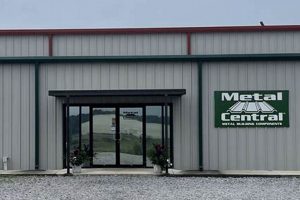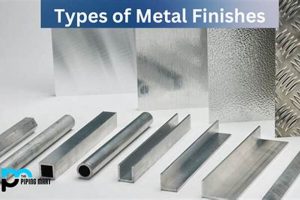The application of specialized treatments to metallic surfaces to achieve extremely close tolerances, improved surface properties, and enhanced aesthetic qualities is a critical process across numerous industries. Examples include processes that refine the exterior of medical implants to ensure biocompatibility and processes that coat aerospace components to increase wear resistance.
This refined surface engineering is essential for optimizing performance, extending product lifecycles, and ensuring regulatory compliance. Historically, methods were rudimentary, but advancements in material science and engineering have led to sophisticated techniques capable of achieving nanometer-scale precision and tailored functionalities. This has enabled breakthroughs in fields ranging from microelectronics to automotive manufacturing.
The subsequent sections will delve into specific methodologies employed, quality control measures implemented, and emerging trends shaping the future of advanced surface treatments. Further discussion will explore the selection criteria for particular applications and the economic considerations involved.
Guidance on High-Accuracy Metallic Surface Treatments
The following recommendations are designed to optimize outcomes in applications requiring high-accuracy metallic surface treatments, ensuring quality, durability, and performance.
Tip 1: Material Selection is Paramount: Choosing the appropriate base metal and subsequent surface treatment depends heavily on the intended application. Consider factors such as corrosion resistance, wear resistance, hardness, and biocompatibility to ensure longevity and functionality.
Tip 2: Define Clear Performance Metrics: Before commencing any treatment, establish quantifiable metrics for surface roughness, coating thickness, and adhesion. These metrics serve as benchmarks for quality control throughout the process.
Tip 3: Control Surface Preparation Rigorously: Surface preparation, including cleaning, degreasing, and etching, is crucial for optimal adhesion and performance. Inadequate preparation can lead to premature coating failure.
Tip 4: Implement Precise Process Control: Maintain strict control over process parameters such as temperature, current density, and chemical concentrations. Deviations can significantly affect the final properties of the treated surface.
Tip 5: Invest in Advanced Analytical Techniques: Employ advanced analytical techniques such as scanning electron microscopy (SEM), X-ray diffraction (XRD), and atomic force microscopy (AFM) to characterize surface morphology and composition.
Tip 6: Adhere to Industry Standards: Compliance with relevant industry standards, such as ISO, ASTM, and MIL-SPEC, is essential for ensuring quality and regulatory compliance.
Tip 7: Thorough Post-Treatment Inspection: Implement a comprehensive post-treatment inspection process to identify any defects or inconsistencies before components are released for use.
Tip 8: Partner with Experienced Professionals: Collaborate with experienced service providers who possess the expertise and resources necessary to deliver consistently high-quality results. Due diligence is crucial in evaluating potential partners.
Adhering to these recommendations will improve the reliability and performance of components requiring refined metallic surface treatments, reducing the risk of premature failure and extending operational lifecycles.
The subsequent discussion will examine specific application scenarios and considerations for future advancements in surface engineering.
1. Dimensional Accuracy
Dimensional accuracy, in the context of refined metallic surface treatments, signifies the degree to which a finished component’s dimensions conform to specified engineering tolerances after the treatment process. Surface treatments, by their nature, add or remove material. If uncontrolled, these additions or subtractions can critically alter the component’s dimensional characteristics, leading to functional impairment or complete failure. For instance, a gear tooth requiring a hard coating must maintain its precise profile to mesh correctly with other gears; deviations exceeding allowed tolerances will result in improper engagement, increased wear, and ultimately, failure of the transmission system. Similarly, in microelectronics, the application of thin films must not compromise the dimensions of delicate circuit features, ensuring the intended electrical performance.
The relationship is therefore one of critical cause and effect. Imprecise application of surface treatments invariably leads to diminished dimensional accuracy. This directly affects the functionality and reliability of finished products across numerous sectors. The importance of dimensional accuracy necessitates the implementation of sophisticated monitoring and control systems throughout the surface treatment process. These systems often involve precise measurements before, during, and after treatment, using techniques such as optical profilometry, coordinate measuring machines (CMMs), and non-destructive testing (NDT) methods. The practical significance of understanding this connection lies in the ability to proactively mitigate risks associated with dimensional deviations, ensuring consistent product quality and performance.
In conclusion, dimensional accuracy is not merely a desirable attribute, but an integral component of successful advanced metallic surface treatments. Maintaining dimensional control is paramount to delivering components that meet stringent performance requirements. Challenges remain in treating complex geometries and miniaturized parts, requiring continuous development of advanced techniques and precise process control. Understanding the interplay between treatment processes and dimensional outcomes is key to achieving the benefits of surface modification without compromising functional integrity.
2. Surface Integrity
Surface integrity, pertaining to the condition of a component’s surface layer, is a primary consideration in refined metallic surface treatments. It encompasses a range of characteristics that dictate the material’s performance and longevity. Treatments must preserve or enhance the surface’s inherent properties to avoid premature failure.
- Residual Stress Management
Refined treatments can induce residual stresses within the surface layer. Compressive residual stresses are generally beneficial, increasing fatigue life and resistance to crack propagation. Conversely, tensile residual stresses are detrimental, promoting crack initiation and accelerated failure. The control of residual stress through techniques like shot peening or controlled heat treatment is essential to maintain optimal surface integrity.
- Microstructural Alterations
Certain surface treatments can cause microstructural changes in the surface layer. For example, carburizing or nitriding introduces carbon or nitrogen atoms into the surface, forming a hard, wear-resistant case. However, excessive or uncontrolled diffusion can lead to grain growth, embrittlement, or the formation of undesirable phases, compromising surface integrity. Precise control of temperature, time, and atmosphere is necessary to manage these microstructural alterations effectively.
- Surface Roughness and Defects
Surface roughness significantly influences friction, wear, and fatigue performance. Surface treatments can either reduce or increase surface roughness depending on the desired outcome. Processes like polishing or electropolishing aim to create smooth, low-friction surfaces. Conversely, treatments such as grit blasting or laser texturing can generate controlled roughness to enhance adhesion or promote lubrication. Minimizing surface defects, such as scratches, pits, and inclusions, is crucial to prevent stress concentrations and premature failure. Non-destructive testing methods like dye penetrant inspection or ultrasonic testing are used to detect and eliminate surface defects.
- Altered Fatigue Life:
Fatigue life will be change with Surface Treatment process. For instance, applying coatings using high-temperature methods may introduce defects, decrease fatigue life. Treatments that generate a smooth surface with favorable compressive residual stress will increase fatigue life.
The aforementioned elements are not independent but rather interconnected aspects of surface integrity. Treatments must be carefully selected and controlled to optimize these characteristics collectively. A holistic approach to surface integrity is essential to ensure that advanced treatments deliver the intended benefits without compromising the overall performance and reliability of finished products. For example, excessive shot peening can induce high compressive stresses but also increase surface roughness, requiring subsequent polishing to restore a smooth finish. A comprehensive understanding of the trade-offs between different surface properties is necessary to achieve the desired outcome.
3. Corrosion Resistance
Corrosion resistance is a critical performance parameter directly affected by sophisticated metallic surface treatments. The degradation of metallic materials due to electrochemical reactions with their environment can lead to structural weakening, functional impairment, and eventual failure. Sophisticated surface modification processes serve to mitigate or eliminate these corrosive effects, significantly extending the service life of components and systems. For example, components utilized in marine environments, where exposure to saltwater is constant, are frequently treated with processes that create a barrier against chloride-induced corrosion. This often involves applying coatings containing zinc or other sacrificial anodes, which corrode preferentially, protecting the underlying base metal. Similarly, pipelines transporting corrosive fluids, such as oil and gas, rely on specialized coatings and surface treatments to prevent leaks and maintain structural integrity. Without these treatments, catastrophic failures and environmental damage could occur.
The importance of corrosion resistance within the framework of refined metallic surface treatments stems from its direct impact on component reliability and long-term cost-effectiveness. Processes employed to enhance resistance include passivation, anodizing, electroplating, and various coating techniques. Passivation, commonly used on stainless steel, forms a thin, inert oxide layer that inhibits further oxidation. Anodizing, primarily applied to aluminum, creates a thicker, more durable oxide layer that provides excellent corrosion protection and abrasion resistance. Electroplating deposits a thin layer of a corrosion-resistant metal, such as chromium or nickel, onto the base metal. The practical significance of understanding these processes lies in the ability to select the optimal treatment for a specific application, considering factors such as the operating environment, mechanical loads, and cost constraints. For example, the choice between electroplating and thermal spraying for corrosion protection depends on the size and geometry of the component, the required coating thickness, and the severity of the corrosive environment.
In summary, corrosion resistance is not merely a desirable attribute but a fundamental requirement for many engineering applications. Refined surface treatment techniques provide the means to achieve and maintain this critical property, ensuring the longevity and reliability of metallic components. Challenges remain in developing treatments that are both highly effective and environmentally sustainable, driving ongoing research into novel materials and processes. Continuous advancements in surface engineering are essential to meeting the increasingly stringent demands of modern industry and infrastructure.
4. Adhesion Strength
Adhesion strength, the measure of the bond integrity between a surface treatment and the underlying substrate, is a primary determinant of the performance and durability of precision-finished metallic components. The effectiveness of any surface treatment, regardless of its intrinsic properties (e.g., hardness, corrosion resistance), is contingent upon its ability to remain integrally bonded to the base metal under operational stresses. Premature delamination or coating failure directly undermines the intended benefits of the finishing process, leading to degraded performance, reduced lifespan, and potential catastrophic failures. Consider, for example, the application of thermal barrier coatings (TBCs) on turbine blades in jet engines. These coatings provide crucial thermal insulation, allowing for higher operating temperatures and improved engine efficiency. However, if the adhesion strength between the TBC and the blade’s superalloy substrate is compromised, the coating can spall off due to thermal cycling and high centrifugal forces, resulting in blade overheating and potential engine failure. Similarly, the long-term effectiveness of protective coatings applied to offshore oil platforms depends on their ability to withstand the harsh marine environment. Poor adhesion can lead to localized corrosion under the coating, accelerating structural degradation.
The interplay between sophisticated surface treatments and adhesion strength necessitates meticulous control over several key parameters during the finishing process. Substrate preparation is paramount, involving cleaning, degreasing, and etching to create a surface that is chemically and mechanically receptive to the applied treatment. Surface roughness, for instance, can be tailored to enhance mechanical interlocking between the coating and the substrate. In addition, the application method itself significantly influences adhesion strength. Techniques such as plasma spraying, chemical vapor deposition (CVD), and physical vapor deposition (PVD) offer varying degrees of control over coating microstructure, density, and composition, all of which directly impact bond integrity. Post-treatment processes, such as heat treatment or surface modification, can further enhance adhesion by promoting diffusion bonding or reducing residual stresses at the interface. The selection of appropriate materials for both the substrate and the surface treatment is also crucial, considering factors such as coefficient of thermal expansion, chemical compatibility, and mechanical properties. Inadequate material selection can lead to interfacial stresses and eventual bond failure.
In conclusion, adhesion strength is not merely a supplementary characteristic but a fundamental requirement for successful advanced metal surface treatments. Optimizing adhesion performance necessitates a comprehensive understanding of the underlying mechanisms governing bond formation and failure, coupled with precise control over the entire finishing process. Ongoing research focuses on developing novel surface preparation techniques, advanced coating materials, and non-destructive testing methods to further enhance adhesion strength and ensure the long-term reliability of precision-finished metallic components. Addressing the challenges associated with achieving robust adhesion is essential to realizing the full potential of refined surface treatments across diverse industrial applications.
5. Material Compatibility
Material compatibility is a cornerstone of successful high-accuracy metallic surface treatments. It refers to the ability of the substrate material and the applied finish to coexist without adverse interactions that compromise the structural integrity, performance, or longevity of the component. Incompatibility can manifest as galvanic corrosion, diffusion-induced embrittlement, or thermal stress-induced cracking, thereby negating the intended benefits of the finishing process. For example, applying a nickel coating directly onto an aluminum alloy in a corrosive environment can create a galvanic couple, leading to rapid corrosion of the aluminum. Similarly, diffusing certain elements from a coating into the substrate at elevated temperatures can result in the formation of brittle intermetallic compounds, weakening the material. Understanding these potential pitfalls is crucial for selecting appropriate material combinations and processing parameters.
The importance of material compatibility within advanced metallic surface treatments lies in its direct impact on component reliability and service life. Careful consideration must be given to the electrochemical potential difference between the substrate and the finish, as well as their respective coefficients of thermal expansion. In applications involving dissimilar metals, such as stainless steel fasteners in carbon steel structures, it may be necessary to introduce a barrier layer or select a compatible coating to prevent galvanic corrosion. In high-temperature applications, such as aerospace components, the thermal expansion mismatch between the substrate and the coating must be minimized to prevent cracking or spalling during thermal cycling. Moreover, the diffusion behavior of elements at the interface between the substrate and the finish must be carefully controlled to avoid the formation of detrimental phases. Practical applications often require thorough testing and characterization to ensure material compatibility under simulated operating conditions. Techniques such as electrochemical impedance spectroscopy, diffusion couple experiments, and thermal cycling tests are commonly employed to assess the long-term stability of material combinations.
In summary, material compatibility is a critical consideration in precision metal finishing. Selecting compatible materials and controlling processing parameters are essential for achieving reliable and durable surface treatments. The challenges associated with material compatibility are particularly acute in applications involving harsh environments, elevated temperatures, or dissimilar metals. Ongoing research focuses on developing novel materials and surface treatment techniques that minimize the risks of incompatibility and enhance the long-term performance of finished components. Ignoring material compatibility can lead to premature failure and costly repairs, underscoring the need for a comprehensive understanding of the interactions between substrate and coating materials.
Frequently Asked Questions
The following addresses common inquiries regarding high-accuracy treatments applied to metallic surfaces, providing clarity on processes, applications, and considerations.
Question 1: What distinguishes “precision metal finishing” from standard metal finishing techniques?
While standard metal finishing aims for general improvements in appearance or protection, high-accuracy treatments focus on achieving exacting dimensional tolerances, specific surface properties, and enhanced performance characteristics. This often involves specialized techniques and stringent quality control measures.
Question 2: In what industries is advanced surface treatment most critical?
Sectors requiring high-performance, reliable components are particularly reliant on refined surface treatment. These include aerospace, medical device manufacturing, microelectronics, automotive, and tooling industries.
Question 3: What are the primary benefits derived from high-accuracy surface modifications?
Benefits include enhanced corrosion resistance, improved wear resistance, increased fatigue life, tailored surface roughness, and precise dimensional control. These improvements contribute to extended product lifecycles, improved performance, and reduced maintenance costs.
Question 4: How is the quality of a refined metallic surface treatment assessed?
Quality assessment involves a range of techniques, including microscopic examination, surface roughness measurements, coating thickness analysis, adhesion testing, and corrosion resistance testing. Non-destructive testing methods are often employed to ensure component integrity.
Question 5: What factors influence the selection of a specific refined surface treatment?
Factors include the base material, operating environment, mechanical loads, required performance characteristics, regulatory requirements, and cost considerations. A comprehensive understanding of these factors is essential for selecting the optimal treatment.
Question 6: Are there environmental concerns associated with high-accuracy metallic surface treatments?
Certain surface treatment processes may involve the use of hazardous chemicals or generate waste products. Environmental regulations and sustainability considerations are driving the development of more eco-friendly alternatives, such as plasma-based techniques and bio-derived coatings.
Understanding the nuances of high-accuracy metallic surface treatments is crucial for optimizing component performance and ensuring long-term reliability across diverse applications.
The subsequent section will delve into emerging trends and future directions in surface engineering.
Conclusion
The preceding exploration of precision metal finishing has underscored its importance in achieving exacting performance criteria across a spectrum of industries. The control of dimensional accuracy, surface integrity, corrosion resistance, adhesion strength, and material compatibility are not merely desirable attributes, but fundamental requirements for ensuring the longevity and reliability of critical components. The discussed methods and considerations highlight the necessity for a comprehensive understanding of material science, engineering principles, and quality control methodologies within this specialized field.
The continued advancement of precision metal finishing techniques remains essential for enabling innovation in diverse sectors. As materials science evolves and performance demands increase, ongoing research and development will be crucial for pushing the boundaries of what is achievable in surface engineering. Investing in advanced processes and maintaining rigorous quality standards are paramount for realizing the full potential of this critical technology. The future hinges on the ability to refine and adapt these processes to meet ever-increasing demands for performance, durability, and sustainability.







![Ultimate Paramount Metal Finishing Guide [Benefits] Best Final Touch: Elevate Your Projects with Professional Finishing Ultimate Paramount Metal Finishing Guide [Benefits] | Best Final Touch: Elevate Your Projects with Professional Finishing](https://bestfinaltouch.com/wp-content/uploads/2025/11/th-285-300x200.jpg)